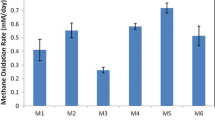Abstract
To analyze the relationship between biomass of microorganisms and methane production, the total biomass of bacteria and archaea (BA) during methane fermentation was analyzed by the environmental DNA analysis method. In the case of using methanogenic sludge as a seed which is generally used for methane fermentation, the total BA biomass reached to 1.5 × 108 to 3.6 × 108 cells/ml when methane was produced. On the other hand, soil suspension was used as a seed; methane was not produced for 14-day cultivation. However, the total BA biomass reached to above 1.5 × 108 cells/ml. The methanogen biomass was counted by using a fluorescence microscope (coenzyme F420), and the methanogen biomass and the ratio of methanogens in the total of BA were analyzed during methane fermentation. At the methane-producing phase, the methanogen biomass reached to 1.3 × 108 cells/ml, and the ratio of methanogens was above 70% of the total BA. When the ratio of methanogens in a seed was changed, the methane-producing phase was moved. However, the relationship between methanogens and other microorganisms at the methane-producing phase was almost similar.



Similar content being viewed by others
Abbreviations
- BA:
-
Bacteria and archaea
- eDNA:
-
Environmental DNA
- DAPI:
-
4′,6-diamino-2-phenylindole
References
Vogels, G. D., Keltjens, J. T., & van der Drift, C. (1988). Biochemistry of methane production. In A. J. B. Zehnder (Ed.), Biology of anaerobic microorganisms (pp. 707–770). New York: Wiley.
Gunaseelan, V. N. (1997). Anaerobic digestion of biomass for methane production: A review. Biomass and Bioenergy, 13, 83–114. doi:10.1016/S0961-9534(97)00020-2.
McCarty, P. L. (2001). The development of anaerobic treatment and its future. Water Science and Technology, 44, 149–156.
Nishio, N., & Nakashimada, Y. (2004). High rate production of hydrogen/methane from various substrates and wastes. Advances in Biochemical Engineering/Biotechnology, 90, 63–87.
Nishio, N., & Nakashimada, Y. (2007). Recent development of anaerobic digestion processes for energy recovery from wastes. Journal of Bioscience and Bioengineering, 103, 105–112. doi:10.1263/jbb.103.105.
Hobson, P. N., & Wheatley, A. D. (1993). Running and control of digesters. In P. N. Hobson, & A. D. Wheatley (Eds.), Anaerobic digestion (pp. 247–257). London: Elsevier.
Jawed, M., & Tare, V. (1999). Microbial composition assessment of anaerobic biomass through methanogenic activity tests. Water SA, 25, 345–350.
Goden, J. -J., Zumstein, E., Dabert, P., Habouzit, F., & Moletta, R. (1997). Molecular microbial diversity of an anaerobic digestor as determined by small-subunit rDNA sequence analysis. Applied and Environmental Microbiology, 63, 2802–2813.
Sekiguchi, Y., Kamagata, Y., Syutsubo, K., Ohashi, A., Harada, H., & Nakamura, K. (1998). Phylogenetic diversity of mesophilic and thermophilic granular sludges determined by 16S rRNA gene analysis. Microbiology, 144, 2655–2665.
Fernández, A., Huang, S., Seston, S., Xing, J., Hickey, R., Criddle, C., et al. (1999). How stable is stable? Function versus community composition. Applied and Environmental Microbiology, 65, 3697–3704.
Tagawa, T., Syutsubo, K., Sekiguchi, Y., Ohashi, A., & Harada, H. (2000). Quantification of methanogen cell density in anaerobic granular sludge consortia by fluorescence in-situ hybridization. Water Science and Technology, 42, 77–82.
Zumstein, E., Moletta, R., & Goden, J. -J. (2000). Examination of two years of community dynamics in an anaerobic bioreactor using fluorescence polymerase chain reaction (PCR) single-strand conformation polymorphism analysis. Environmental Microbiology, 2, 69–78. doi:10.1046/j.1462-2920.2000.00072.x.
Hori, T., Haruta, S., Ueno, Y., Ishii, M., & Igarashi, Y. (2005). Direct comparison of single-strand conformation polymorphism (SSCP) and denaturing gradient gel electrophoresis (DGGE) to characterize a microbial community on the basis of 16S rRNA gene fragments. Journal of Microbiological Methods, 66, 165–169. doi:10.1016/j.mimet.2005.11.007.
Yu, Y., Lee, C., & Hwang, S. (2005). Analysis of community structures in anaerobic processes using a quantitative real-time PCR method. Water Science and Technology, 52, 85–91.
Jain, M. K., Zeikus, J. G., & Bhatnagar, L. (1991). Methanogens. In P. N. Levett (Ed.), Anaerobic microbiology (pp. 223–245). Oxford: Oxford University Press.
Aoshima, H., Kimura, A., Shibutani, A., Okada, C., Matsumiya, Y., & Kubo, M. (2006). Evaluation of soil bacterial biomass using environmental DNA extracted by slow-stirring method. Applied Microbiology and Biotechnology, 71, 875–880. doi:10.1007/s00253-005-0245-x.
Mink, R. W., & Dugan, P. R. (1977). Tentative identification of methanogenic bacteria by fluorescence microscopy. Applied and Environmental Microbiology, 33, 713–717.
Ihara, I., & Maekawa, T. (1999). Measurement of methanogenic bacteria by fluorescence coenzyme F420 using image analysis. Nougyou Shisetsu, 30, 247–256 in Japanese.
Harada, H., Ohashi, A., & Imachi, H. (2004). Realization of super high-rate methane fermentation bioreactor and rRNA-based molecular analysis of sludge consortium. Journal of Environmental Biotechnology, 4, 19–27 in Japanese.
Schnurer, A., Schink, B., & Svensson, B. H. (1996). Clostridium ultunense sp. nov., a mesophilic bacterium oxidizing acetate in syntrophic association with a hydrogenotrophic methanogenic bacterium. International Journal of Systematic Bacteriology, 46, 1145–1152.
Imachi, H., Sekiguchi, Y., Kamagata, Y., Ohashi, A., & Harada, H. (2000). Cultivation and in situ detection of a thermophilic bacterium capable of oxidizing propionate in syntrophic association with hydrogenotrophic methanogens in a thermophilic methanogenic granular sludge. Applied and Environmental Microbiology, 66, 3608–3615. doi:10.1128/AEM.66.8.3608-3615.2000.
de Bok, F. A. M., Plugge, C. M., & Stams, A. J. M. (2004). Interspecies electron transfer in methanogenic propionate degrading consortia. Water Research, 38, 1368–1375. doi:10.1016/j.watres.2003.11.028.
Luo, H. -W., Zhang, H., Suzuki, T., Hattori, S., & Kamagata, Y. (2002). Differential expression of methanogenesis genes of Methanothermobacter thermoautotrophicus (formerly Methanobacterium thermoautotrophicum) in pure culture and in cocultures with fatty acid-oxidizing syntrophs. Applied and Environmental Microbiology, 68, 1173–1179. doi:10.1128/AEM.68.3.1173-1179.2002.
Author information
Authors and Affiliations
Corresponding author
Rights and permissions
About this article
Cite this article
Kubota, K., Ozaki, Y., Matsumiya, Y. et al. Analysis of Relationship Between Microbial and Methanogenic Biomass in Methane Fermentation. Appl Biochem Biotechnol 158, 493–501 (2009). https://doi.org/10.1007/s12010-008-8477-8
Received:
Accepted:
Published:
Issue Date:
DOI: https://doi.org/10.1007/s12010-008-8477-8




